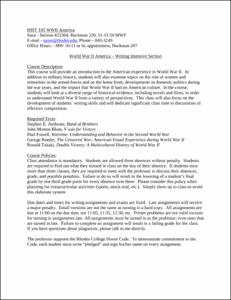Please use this identifier to cite or link to this item:
http://hdl.handle.net/10267/15921| Title: | HIST 105-04, WWII America, Spring 2013 |
| Authors: | Saxe, Robert F. |
| Keywords: | History, Department of;Syllabus;Text;Curriculum;2013 Spring |
| Issue Date: | 9-Jan-2013 |
| Publisher: | Memphis, Tenn. : Rhodes College |
| Series/Report no.: | Syllabi CRN;23364 |
| Abstract: | In 1927 the great American medievalist Charles Homer Haskins published his classic work, The Renaissance of the Twelfth Century. The book was both an assessment of what was a widely-recognized turning point in European history and culture and an appropriation for that period of the recently popularized term “renaissance,” by then conventionally located in the late fourteenth through the late sixteenth centuries. The purpose of this course is fourfold: to look at Haskins’ great book, to consider aspects of the twelfth century that Haskins did not, to reconsider some of those that he did, and to ponder his and others’ use of the term “renaissance” to describe the twelfth century. Thus this seminar will sample the wide range of intellectual, political, institutional, spiritual, and cultural developments that took place in Western Europe between the late eleventh century and the late twelfth century, using primary sources as our guide and supplemented by generous readings from the best recent scholarship. Among the topics we will investigate are the study of the liberal arts in cathedral schools and the first universities; the centralization of political authority in France and England; the spiritual renewal associated with new monastic orders; the music and poetry of the traveling Minstrels that embody the twelfth-century spirit of chivalry and courtly love; and the increasingly fraught relations between Christians and Jews that resulted in part from this intellectual renaissance. The overall attitude towards learning during this period is perhaps best exemplified in the memorable phrase of Bernard of Chartres, who described the scholars of his generation as being “like dwarfs perched on the shoulders of giants: we see more and farther than our predecessors, not because we have keener vision or greater height, but because we are lifted up and borne aloft on their gigantic stature.” It is our goal to approach all the readings with this motto in mind. |
| Description: | This syllabus was submitted to the Office of Academic Affairs by the course instructor. Uploaded by Archives RSA Josephine Hill. |
| URI: | http://hdl.handle.net/10267/15921 |
| Appears in Collections: | Course Syllabi |
Files in This Item:
| File | Description | Size | Format | |
|---|---|---|---|---|
| 2013_Spring_HIST 105_04_23364.pdf | 45.6 kB | Adobe PDF |  View/Open |
Items in DSpace are protected by copyright, with all rights reserved, unless otherwise indicated.